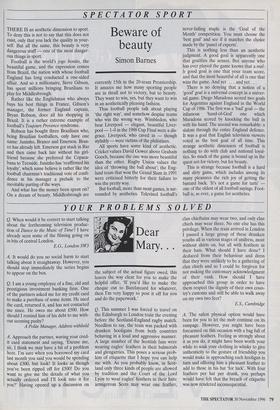SPECTATOR SPORT
Beware of beauty
Simon Barnes
THERE IS an aesthetic dimension to sport. To deny this is not to say that this does not exist, only that you lack the quality in your- self. But all the same, this beauty is very dangerous stuff — one of the most danger- ous things in sport.
Football is the world's jogo bonito, the beautiful game, and the expression comes from Brazil, the nation with whose football England has long conducted a one-sided affair. And so a millionaire, Steve Gibson, has spent millions bringing Brazilians to play for Middlesbrough.
Rather like the Englishman who always buys his best things in France, Gibson's manager, the former England captain, Bryan Robson, does all his shopping in Brazil. It is a rather extreme example of football's Toujours Provence syndrome.
Robson has bought three Brazilians who, being Brazilian footballers, only have one name: Juninho, Branco and Emerson. Bran- co has already left. Emerson got stuck in Rio and then came back late without his girl- friend because she preferred the Copaca- bana to Teesside. Juninho has 'reaffirmed his loyalty', which some believe is rather like the football chairman's traditional vote of confi- dence in his manager a prelude to the inevitable parting of the ways.
And what has the money been spent on? On a dream of beauty. Middlesbrough are currently 15th in the 20-team Premiership. It amazes me how many sporting people are in thrall not to victory, but to beauty. They want to win, yes, but they want to win in an aesthetically pleasing fashion.
Thus football people talk about playing 'the right way', and somehow despise teams who win the wrong way. Wimbledon, who beat Liverpool — elegant, beautiful Liver- pool — 1-0 in the 1988 Cup Final were a dis- grace. Liverpool, who caved in — though stylishly — were victims of the philistines.
All sports have some kind of aesthetic. Cricket values David Gower above Graham Gooch, because the one was more beautiful than the other. Rugby Union values the idea of 'throwing the ball about'; the Eng- land team that won the Grand Slam in 1991 were criticised bitterly for their failure to win the pretty way.
But football, more than most games, is sur- rounded by aesthetics. Televised football's never-failing staple is the 'Goal of the Month' competition. You must choose the 'best goal' and see if it matches the choice made by the 'panel of experts'.
This is nothing less than an aesthetic judgment. A good goal is apparently one that gratifies the senses. But anyone who has ever played the game knows that a real- ly good goal is one that your team score, and that the most beautiful of all is one that wins the game. And yet . . . and yet . . .
There is no denying that a notion of a 'good' goal is a universal concept in a univer- sal game. Diego Maradona scored two goals for Argentina against England in the World Cup of 1986. The first was a 'bad' goal — the infamous 'hand-of-God' one which Maradona scored by knocking the ball in with his hand. The second was remarkable: a slalom through the entire England defence. It was a goal that English television viewers voted as the best goal of all time. This strange aesthetic dimension of football is nothing to do with club and national loyal- ties. So much of the game is bound up in the quest not for victory, but for beauty.
This is strange because football is a hard and dirty game, which includes among its many pleasures the rich joy of getting the bastard back. 'It's not a game for tarts' — one of the oldest of all football sayings. Foot- ball is, as ever, a game for aesthetes.


















































































 Previous page
Previous page